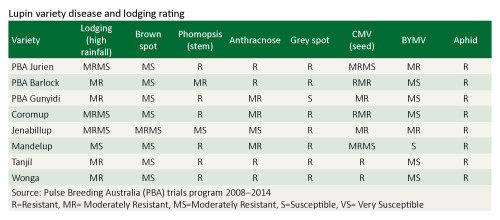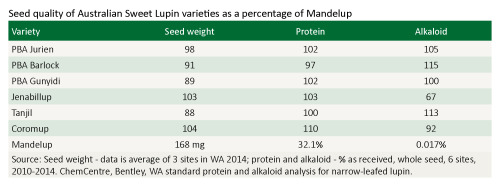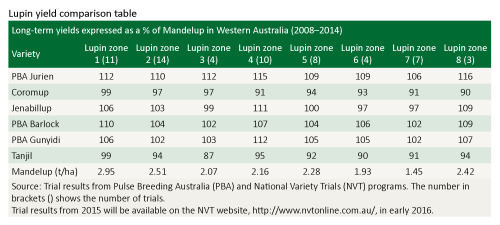Lupin variety choices in Western Australia are outlined, including disease and lodging rating, grain quality and yield and adaptation for each lupin zone.
Lupin variety choices for WA
Variety adaptation and description
 PBA Jurien (released 2015)
Recommended for all lupin zones in Western Australia
PBA Jurien (released 2015)
Recommended for all lupin zones in Western Australia
- Highest yielding across all lupin growing areas of WA
- Resistant ® to anthracnose, (equivalent to PBA Barlock)
- Resistant ® to phomopsis (equivalent to PBA Gunyidi)
- Resistant ® to grey spot (equivalent to PBA Barlock)
- Moderately Resistant (MR) to BYMV, similar to Jenabillup
- Tolerant to metribuzin (superior to PBA Barlock, similar to Coromup)
- Moderate resistance to pod shattering (equal to Coromup)
- Early flowering and early maturity
- Pale seed coat with seed size similar to Mandelup
PBA Barlock (released 2013)
Suitable for Lupin zone 1 with almost equivalent yield to PBA Jurien and resistance to Anthracnose.
- High yielding across most lupin zones of WA
- Resistant ® to anthracnose (equal to Tanjil and Wonga)
- Tolerant to metribuzin (equal to Mandelup)
- Improved resistance to pod shattering (equal to Tanjil and Coromup)
- Moderately Resistant (MR) to phomopsis stem blight (equal to Tanjil and Wonga)
- Early flowering and early maturity
PBA Gunyidi (released 2010)
Suited to later sowing opportunities due to its earliest flowering and maturity habit. PBA Gunyidi has delivered better commercial yield performance than its release data suggests, though currently outclassed in all lupin zones by PBA Jurien.
- High yielding across most lupin growing areas of WA
- Improved resistance to pod shattering (equal to Coromup)
- Resistant to anthracnose (equal to PBA Barlock)
- Moderately Resistant (MR) to phomopsis stem blight (equal to Tanjil)
- Early flowering and early maturity
- Susceptible to grey spot
Coromup (released 2006)
Recommended where end users have a specific requirement for high protein in lupin, however Coromup is not yield competitive with PBA Jurien.
- High quality variety for medium and low rainfall zones
- Highest protein content of all lupin varieties, about 2% higher
- Excellent height and vigour in low-medium rainfall environments
- Early maturity – suitable for croptopping
- Good anthracnose resistance
- Good resistance to aphid colonisation and feeding damage
- Highest tolerance to the broadleaf herbicide metribuzin
Jenabillup (released 2007)
Suitable to lupin zone 8 where Bean Yellow Mosaic Virus (BYMV) can cause high yield loss.
- High yielding narrow leaf lupin variety for the high and medium rainfall areas of Western Australia
- Moderately Resistant (MR) to BYMV, also known as black pod syndrome
- Best resistance to brown-leaf spot of any lupin variety
- Mid-maturing variety
- Moderately resistant to seed transfer of Cucumber Mosaic Virus (CMV)
- Not tolerant of metribuzin
Mandelup (released 2004)
Outclassed for yield by PBA Jurien in all Lupin zones.
- Consistently high yielding variety across all lupin zones
- Excellent height and vigour in low-medium rainfall environments
- Early maturity – suitable for croptopping
- Moderately Resistant (MR) to anthracnose
- Good resistance to aphid colonisation
- Susceptible to pod shedding with delayed harvest
Tanjil (released 1998)
Totally outclassed for yield in all lupin zones in WA.
- Late flowering and maturity
- Resistant to anthracnose
- Not tolerant of metribuzin
- Good tolerance to pod shedding from delayed harvest
Production recommendations Production recommendations and variety management packages are available on the Pulse Australia website.


WA lupin zones
The lupin production zones were chosen to distinguish areas with broadly similar farming systems and yield potential, similar constraints to production and similar management requirements.
For example, Zones 3 and 7 are drier and therefore have lower yield potential than the others; but Zone 7 has colder winters and a higher risk of brown spot than Zone 3 so wider rotations may be better in Zone 7.
Similarly, naturalised sandplain lupin is more common in Zone 1, so anthracnose risk is higher than in Zone 2 and different cultivars are recommended.
In the south, abortion of pods on the main stem is more common in Zone 8 than elsewhere, so different cultivars are recommended here.
Source: ‘Producing Lupins’, DAFWA 2008

Seed supply enquiries
AUSTRALIAN SEED & GRAIN P/L Berkshire Valley Rd PO Box 183, Moora, WA 6510 Chris Martin Tel: 08 9651 1069 Fax: 08 9651 1542 Email: info@austseedgrain.com.au
EDSCO Eastern Districts Seed Cleaning Co Cnr Mill St & Mather Road PO Box 21, Kellerberrin WA 6410 Ian Doncan Tel: 08 9045 4036 Fax: 08 9045 4539
MultiSEED Productions 4 Brockman St, Esperance WA 6450 William Sharp Tel: 08 9071 1053 Fax: 08 9071 5007
For more information please contact Alan Meldrum, Pulse Australia (Industry Development Manager – Western) P: 0427 384 760
Visit Pulse Australia

